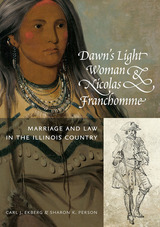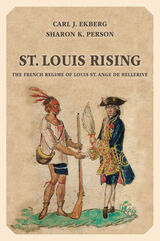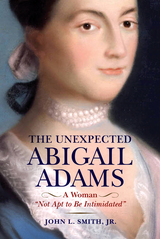3 books by Person, Sharon K.

Carl J. Ekberg
University of Missouri Press
Ste. Genevieve (designated a National Historic Park in 2020) was the first permanent European settlement established on the west side of the Mississippi in Upper Louisiana, antedating St. Louis by more than a decade, and Louis Bolduc was its best-known citizen. Bolduc arrived in the Old Town of Ste. Genevieve ca. 1761, as the French and Indian War was winding down. With a focus on Bolduc and his family, readers are given a window into the workings of a rapidly evolving village during the colonial era. The depiction of Bolduc is not strictly biographical as a single historical figure but rather is set within the context of his two successive wives, his children, his neighbors, his enslaved people, and his built environment, including his famous French vertical log house. The book provides the foundation for narratives on non-British colonies, Native American interactions with colonists, and the situation of Native American and African American slavery, all within the context of Missouri before it became a state.
[more]

Dawn's Light Woman & Nicolas Franchomme
Marriage and Law in the Illinois Country
Carl J. Ekberg and Sharon K. Person
Southern Illinois University Press, 2022
WINNER, 2023 Illinois State Historical Society Superior Achievement Award in “Books, Scholarly”!
Native women’s marital rights and roles in colonial Illinois society
Kaskaskia, Illinois, once the state’s capital, torn from the state by flood waters, and now largely forgotten, was once the home to a couple who helped transform the region in the 1720s from a frontier village to a civil society. In the heart of France’s North American empire, the village was a community of French-Canadian fur traders and Kaskaskia Indians who not only lived together but often intermarried. These Indigenous and French intermarriages were central to colonial Illinois society, and the coupling of Marguerite 8assecam8c8e (Dawn’s Light Woman) and Nicolas Franchomme, in particular, was critical to expanding the jurisdiction of French law.
While the story of Marguerite and Nicolas is unknown today, it is the story of how French customary law (Coutume de Paris) governed colonial marriage, how mixed Indian-French marriages stood at the very core of early colonial Illinois society, and how Illinois Indian women benefited, socially and legally, from being married to French men. All of this came about due to a lawsuit in which Nicolas successfully argued that his wife had legal claim to her first husband’s estate—a legal decision that created a precedent for society in the Illinois Country.
Within this narrative of a married couple and their legal fight—based on original French manuscripts and supported by the comprehensively annotated 1726 Illinois census—is also the story of the village of Kaskaskia during the 1720s, of the war between Fox Indians and French settlers, with their Indian allies, in Illinois, and of how the spread of plow agriculture dramatically transformed the Illinois Country’s economy from largely fur trade–based to expansively agricultural.
Native women’s marital rights and roles in colonial Illinois society
Kaskaskia, Illinois, once the state’s capital, torn from the state by flood waters, and now largely forgotten, was once the home to a couple who helped transform the region in the 1720s from a frontier village to a civil society. In the heart of France’s North American empire, the village was a community of French-Canadian fur traders and Kaskaskia Indians who not only lived together but often intermarried. These Indigenous and French intermarriages were central to colonial Illinois society, and the coupling of Marguerite 8assecam8c8e (Dawn’s Light Woman) and Nicolas Franchomme, in particular, was critical to expanding the jurisdiction of French law.
While the story of Marguerite and Nicolas is unknown today, it is the story of how French customary law (Coutume de Paris) governed colonial marriage, how mixed Indian-French marriages stood at the very core of early colonial Illinois society, and how Illinois Indian women benefited, socially and legally, from being married to French men. All of this came about due to a lawsuit in which Nicolas successfully argued that his wife had legal claim to her first husband’s estate—a legal decision that created a precedent for society in the Illinois Country.
Within this narrative of a married couple and their legal fight—based on original French manuscripts and supported by the comprehensively annotated 1726 Illinois census—is also the story of the village of Kaskaskia during the 1720s, of the war between Fox Indians and French settlers, with their Indian allies, in Illinois, and of how the spread of plow agriculture dramatically transformed the Illinois Country’s economy from largely fur trade–based to expansively agricultural.
[more]

St. Louis Rising
The French Regime of Louis St. Ange de Bellerive
Carl J. Ekberg and Sharon K. Person
University of Illinois Press, 2015
The standard story of St. Louis's founding tells of fur traders Pierre Laclède and Auguste Chouteau hacking a city out of wilderness. St. Louis Rising overturns such gauzy myths with the contrarian thesis that French government officials and institutions shaped and structured early city society. Of the former, none did more than Louis St. Ange de Bellerive. His commitment to the Bourbon monarchy and to civil tranquility made him the prime mover as St. Louis emerged during the tumult following the French and Indian War.
Drawing on new source materials, the authors delve into the complexities of politics, Indian affairs, slavery, and material culture that defined the city's founding period. Their alternative version of the oft-told tale uncovers the imperial realities--as personified by St. Ange--that truly governed in the Illinois Country of the time, and provide a trove of new information on everything from the fur trade to the arrival of the British and Spanish after the Seven Years' War.
Drawing on new source materials, the authors delve into the complexities of politics, Indian affairs, slavery, and material culture that defined the city's founding period. Their alternative version of the oft-told tale uncovers the imperial realities--as personified by St. Ange--that truly governed in the Illinois Country of the time, and provide a trove of new information on everything from the fur trade to the arrival of the British and Spanish after the Seven Years' War.
[more]
READERS
Browse our collection.
PUBLISHERS
See BiblioVault's publisher services.
STUDENT SERVICES
Files for college accessibility offices.
UChicago Accessibility Resources
home | accessibility | search | about | contact us
BiblioVault ® 2001 - 2024
The University of Chicago Press









